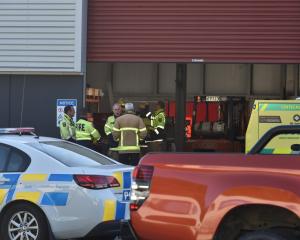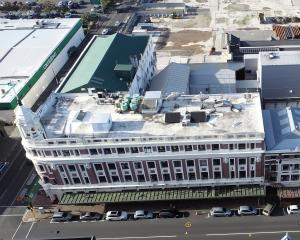At an eventful resource consent hearing in Dunedin yesterday, applicant Luke Dirkzwager argued through his consultants one of the buildings was in such poor condition a moderate earthquake could cause it to collapse.
That had the unintended consequence of causing such concern to committee chairman Cr Colin Weatherall about the threat to public safety, he briefly stopped the meeting to get an assurance from Mr Dirkzwager he would raise the matter with council officers without delay.
[comment caption=Would these buildings be missed?]The hearing was also remarkable in that while almost every resource consent hearing in Dunedin involves former council staff members working as consultants for applicants, yesterday's committee heard former staff member Mark Garden, now a consultant architect, arguing it should bypass guidelines he personally wrote into the district plan when he worked for the council.
Concern was also raised by committee members that in the current economic climate the buildings could be demolished, the project then fall over, and the city be left with an ugly hole.
The row of pre-1900 buildings just south of Stafford St and one building in Stafford St would be demolished to make way for an apartment and retail development by Mr Dirkzwager's company, Prista Apartments, under the terms of the proposal.
A major issue seized upon by opponents was the applicant's decision not to provide a heritage impact report.
That prompted historic places trust chairman Owen Graham to say he was "surprised and shocked" the council had allowed it even to be notified.
But the heritage value claimed by opponents did not impress the applicant's witnesses, consultant planner Allan Cubitt describing such value as "limited".
The relationship between the trust and the developer's team appeared strained, with both sides taking pot shots at each other as the hearing progressed.
Mr Dirkzwager argued if new building did not go ahead, the city would be left with deteriorating, even collapsing, buildings that nobody would be interested in developing because of their status within a townscape precinct under the council's district plan.
Cr Fliss Butcher closely questioned the applicant's counsel, Simon Ford, asking if cost was the reason no heritage impact report had been provided.
Mr Ford replied it was, and that the time involved was also a factor.
Mr Cubitt said it had not been possible to get experts to do an assessment in time for the hearing, but the applicant would do so if the New Zealand Historic Places Trust required an archaeological assessment.
Cr Weatherall, who with Crs Butcher and Richard Walls will make a decision on the issue, stopped Cr Butcher in her questioning.
He said it was at the applicant's risk if an assessment was not produced.
In his evidence, Mr Dirkzwager said, "I fully appreciate the importance of our heritage and I do not believe in destroying heritage property unless absolutely necessary."
But the buildings were in a "severe state of disrepair"- worse than he originally thought.
Consultant engineer Peter Stevenson said partial collapse of 386 Princes St was likely to occur within 10 years, assuming it was not subject to even a moderate earthquake.
To retain the facade would be possible at great cost but would be impractical.
If the development did not proceed, work would have to be done to make the buildings safe, "for little to no real-estate gain".
Cr Weatherall said that issue was not within the committee's sphere of concern, a point on which Mr Stevenson agreed.
Mr Garden said his original recommendation for the project was to retain and reuse the facades.
But when the poor state of the buildings became clear, his client instructed him to plan an entirely new development.
Asked by Cr Weatherall what the driving force was behind his change of mind concerning the facades, Mr Garden said it was both the condition of the building and the wishes of his client.
"As an architect, you respect the wishes of the client."
Mr Cubitt criticised the trust's submission, which he said suggested the committee was not in a position to assess heritage values because there was no report from a suitably qualified person.
"I believe this is wrong," Mr Cubitt said.
"The trust have questioned the professionalism of my office in preparing this application but do not appear to apply the same standard to themselves."
Mr Cubitt said only the building's facades were protected by the district plan, and the buildings were in a townscape as opposed to a heritage precinct.
"The buildings are not classified by the New Zealand Historic Places Trust.
"Why suddenly is the heritage so significant at this site now?"Mr Graham told the committee there was a view among "development-minded parties" the trust opposed development.
"That is absolutely not correct."
But the problem with the developer's approach, he said, was that demolition of the buildings provided the starting point, as opposed to an understanding of their heritage value.
Trust archaeologist Dr Matthew Schmidt told the committee the site had the only surviving 19th-century bread ovens still in place, making the site one of national significance.
He and other trust witnesses said the design of the development might be affected once an assessment had been made and, therefore, the application should be rejected in its entirety.
The hearing continues today.
Advertisement













